2. 中国科学院地球科学研究院, 北京 100029;
3. 中国科学院大学, 北京 100049
2. Institutions of Earth Science, Chinese Academy of Sciences, Beijing 100029, China;
3. University of Chinese Academy of Sciences, Beijing 100049, China
角闪石成分能够记录岩浆演化的物理化学条件等重要信息(Marks et al., 2004; Molina et al., 2009; El-Rahman et al., 2012; Hsu et al., 2017)。相比于其他矿物,钙质火成角闪石具有显著的成分多样性,常被用来定性或定量地推断岩浆过程(Bachmann and Dungan, 2002; Browne and Gardner, 2006; Ridolfi et al., 2008, 2010; Rutherford and Iii, 2008; Thornber et al., 2008; Turner et al., 2013; Erdman et al., 2014)。在镁铁-超镁铁质岩中,角闪石常常作为橄榄石、单斜辉石、斜方辉石、长石和铬铁矿的填隙矿物或以上矿物的包裹体,记录了岩浆演化,对地幔源区的含水性也有一定指示(Polat, 2014)。
角闪石能够在宽泛的P-T范围内稳定(Allen and Boettcher, 1983; Ulmer, 2007; Nandedkar et al., 2014)。姜常义和安三元(1984)指出钙质角闪石主量元素的含量受温度和压力的控制,其化学成分或能指示岩浆的来源。角闪石作为温度计使用已经得到广泛的认可,作为压力计还存在一些争议(Blundy and Holland, 1990; Bachmann and Dungan, 2002; Rutherford and Devine, 2003; Shane and Smith, 2013; Erdman et al., 2014)。Hammarstrom and Zen (1986)的实验研究表明钙角闪石的形成压力与其全铝含量呈线性正相关,Blundy and Holland (1990)却认为角闪石中Al含量对温度很敏感,故此关系基于一定的温度范围才能成立。Anderson and Smith (1995)用角闪石的结晶温度校准压力,然而其适用范围十分受限(T<800℃, Fe/(Fe+Mg)<0.65)。最近,Ridolfi et al. (2010)和Ridolfi and Renzulli (2012)发表了独立的角闪石组分估算其形成压力的经验公式,适用于地幔到下地壳到上地壳的压力范围。另一方面,随着氧逸度的增加,角闪石的Mg含量、Mg#、Fe3+/Fetotal会升高,Ti含量会降低(Otten, 1984; Anderson and Smith, 1995; Scaillet and Evans, 1999; King et al., 2000; El-Rahman et al., 2012; Krawczynski et al., 2012; Shane and Smith, 2013),且氧逸度的变化会影响角闪石阳离子晶格占位(Dalpé and Baker, 2000)。Ridolfi et al. (2010)和Ridolfi and Renzulli (2012)同样给出了通过角闪石的成分计算其结晶时岩浆氧逸度的经验公式,Erdmann et al. (2014)的实验证实前者的算法更具有说服力。此外,角闪石组分还受控于熔体的H2O含量,熔体中H2O含量升高会导致角闪石的Ti含量降低,Si含量、Altotal、K含量升高(Scaillet and Evans, 1999; Adam et al., 2007; Shane and Smith, 2013)。Stone et al. (2003)的研究表明,熔体中至少有2%~3%的H2O时,角闪石才能快速结晶,且角闪石在高温下结晶时需要更高的熔体H2O含量(Bucholz et al., 2014)。角闪石的微量元素配分模式受控于晶体化学和岩浆成分,与产出环境和同化混染程度息息相关(Klein et al., 1997; Bottazzi et al., 1999; Hilyard et al., 2000; Tiepolo et al., 2007; Demény et al., 2012; Dessimoz et al., 2012)。综上所述,角闪石作为名义上的含水矿物,在镁铁-超镁铁质岩中能够贯通出现,不同于早期结晶的橄榄石、单斜辉石和斜方辉石,在示踪岩浆源区和过程方面有独特的作用。因而,对比研究角闪石的成分变化能够很好地指示岩浆演化过程中温度压力、氧逸度和水含量变化,从而示踪岩浆源区、制约岩浆及成矿过程。
新疆东天山地区沿康古尔断裂及其边缘分布了一系列早二叠世赋存铜镍硫化物矿床的镁铁-超镁铁质杂岩体,例如图拉尔根、香山、黄山东、黄山南、黄山、天宇和白石泉岩体等,其成岩成矿过程研究资料十分详实(秦克章等, 2002, 2006, 2007; Zhou et al., 2004; 姜常义等, 2004; Chai et al., 2008; Mao et al., 2008, 2014, 2016, 2017; Qin et al., 2011; 邓宇峰等, 2011; Tang et al., 2011, 2012, 2013; Sun et al., 2013; Zhao et al., 2017; Shi et al., 2018),主要的矿物学研究集中在橄榄石和辉石(Li et al., 2007; 孙赫等, 2007; 邓宇峰等, 2011; Su et al., 2012; Sun et al., 2013; Mao et al., 2014; 薛胜超等, 2015),而这些矿床角闪石的种属、成分特征、成因意义以及区域变化等方面的研究仍相对薄弱。角闪石的化学成分与母岩浆物理化学条件和演化过程的关系也缺乏系统的厘定。本研究通过对东天山地区觉罗塔格带和中天山地块两个构造单元内四个镁铁-超镁铁质杂岩体中的角闪石进行了系统的研究工作,寻找其内在规律,制约不同构造单元的岩浆过程,并分析了它们对于岩浆型铜镍矿床形成的指示意义。
1 区域地质和矿床地质以沙泉子断裂为界,东天山分为觉罗塔格构造带和中天山地块两个构造单元,属于中亚造山带铜镍矿的主要产地(图 1)。这两个构造单元内分布着许多镁铁-超镁铁质杂岩体。如觉罗塔格构造带内的图拉尔根、串珠、马蹄、葫芦、香山、黄山、黄山东杂岩体,中天山地块的天宇、白石泉杂岩体。本文的研究对象选取为觉罗塔格构造带内的图拉尔根和香山杂岩体以及中天山地块中的天宇和白石泉杂岩体。图拉尔根岩体和香山岩体受NEE向展布的康古尔塔格—黄山-镜儿泉韧性剪切带控制的,大地构造背景为碰撞造山后的弛张(孙赫等, 2008)。天宇和白石泉岩体北部为阿齐库都克-沙泉子断裂带,该断裂带被认为是中天山与觉罗塔格岛弧带的缝合带(马瑞士等, 1993; Xiao et al., 2004; 毛启贵等, 2006)。天宇和白石泉岩体形成于后碰撞伸展背景下,与经历过早期俯冲板片改造作用的软流圈地幔的部分熔融和上涌密切相关(柴凤梅等, 2006; Chai et al., 2008; 唐冬梅等, 2009)。

|
图 1 东疆地区大地构造位置及镁铁-超镁铁岩体分布图(据Su et al., 2012修改) Fig. 1 Geologic map of the eastern Xinjiang and distribution of mafic-ultramafic complexes (modified after Su et al., 2012) |
图拉尔根镁铁-超镁铁质岩体位于觉罗塔格构造带的东北部,围岩是中泥盆统变质火山碎屑沉积建造(秦克章等, 2002)。矿区出露三个杂岩体,Ⅰ号岩体为成矿岩体,其岩相对称分异特征明显,从两侧到中间分别是角闪辉长岩、角闪辉橄岩和角闪橄榄岩(三金柱等, 2010),是多期岩侵位的结果(刘艳荣等, 2012)。矿化主要位于橄榄岩相和橄辉岩相,矿体形态为透镜状,脉状等(孙赫等, 2006)。主要金属矿物是磁黄铁矿、黄铜矿、镍黄铁矿(三金柱等, 2010)。
香山镁铁-超镁铁质岩体位于觉罗塔格构造带的西部,围岩是下石炭统的火山碎屑沉积建造(孙赫等, 2008)。杂岩体以具有同期多次侵位的辉长岩为主,也含有一定的角闪辉石岩和单辉橄榄岩,主要赋矿岩相为橄榄岩相、辉石岩相和辉长岩相,矿体形态为似层状、透镜状等(竺国强等, 1995; 秦全新, 2003; 孙赫等, 2008)。
天宇镁铁-超镁铁质岩体位于中天山地块的北部,围岩是中元古界的变质岩,杂岩体主要由辉长岩、辉石岩、橄辉岩、辉橄岩和橄榄岩组成,赋矿岩相岩为橄辉岩相、辉橄岩相及橄榄岩相,金属矿物以磁黄铁矿为主,镍黄铁矿、黄铜矿、紫硫镍矿、辉铜矿次之(唐冬梅等, 2009)。
白石泉镁铁-超镁铁质杂岩体位于中天山地块的北部,直接围岩是中元古界的变质岩(毛启贵等, 2006)。杂岩体具有2个侵入阶段、7个岩相带,主要岩相为闪长岩相、辉长岩相、苏长岩相、角闪石岩相、橄榄岩相、橄长岩相和辉石岩相(柴凤梅等, 2006)。主要赋矿岩相为辉石岩相及部分橄榄岩相。
2 样品采集及分析方法本研究选取了图拉尔根、香山、天宇、白石泉钻孔及地表相对新鲜的样品,图拉尔根的样品岩性为含长橄榄岩、角闪辉石橄榄岩和角闪橄榄岩,香山的样品均为辉石橄榄岩,天宇和白石泉的样品岩性分别为含长角闪辉石橄榄岩和橄榄辉石岩。对样品进行了0.05mm光薄片的磨制,镜下挑选了新鲜的角闪石颗粒进行主量和微量元素的分析。
角闪石的主量元素分析在中国科学院地质与地球物理研究所岩石圈演化国家重点实验室的电子探针JXA8100上完成,其工作电压为15kV,电流20nA,束斑大小为3~5μm。使用的标准样品为天然样品和人工合成氧化物,分析精确度优于2.0%。
角闪石的微量元素分析在中国地质大学(武汉)地质过程与矿产资源研究重点实验室的LA-ICP-MS上测试完成,工作原理和数据处理过程详见Liu et al. (2008)。激光剥蚀系统是配备Agilent 7500a激光器的GeoLas 2005,激光剥蚀半径为44μm,激光脉冲为8Hz,检测限小于46×10-6。
3 结果显微镜下观察得知东天山四个矿床大多数的角闪石均自形程度较好(图 2a-c),多呈嵌晶结构(图 2b, c),粒径在0.5~2mm之间。本文使用WinAmphcal软件(Yavuz, 2007),基于23(O)对角闪石数据进行了阳离子数和配位的计算(表 1)。按照国际矿物学协会角闪石专业委员会提出的命名原则,角闪石(Ca+Na)B≥1.0时为钙角闪石,通常情况下,钙角闪石的CaB≥1.5。东天山四个矿床的角闪石样品中,除天宇矿床的1400-3-6样品CaB=1.38外,其他都属于钙角闪石。对于这些钙角闪石,以(Na+K)A、Ti和CaA原子数作为参数,根据其硅原子数和镁值进行投图(Leake et al., 1997),进一步对其进行分类,得出这四个矿区钙角闪石分别是韭闪石、镁绿钙闪石、钛闪石、浅闪石、钙镁闪石和镁闪石(图 3)。而1400-3-6的成分特征属于钠-钙角闪石中的冻蓝闪石亚类。

|
图 2 东天山铜镍矿床角闪石结构的显微照片 (a)自形角闪石;(b、c)嵌晶结构/包橄结构角闪石;(d)不同成因角闪石. (a、b)于正交偏光下拍摄;(c、d)于单偏光下拍摄. Amp-角闪石;Ol-橄榄石;Cpx-单斜辉石;Opx-斜方辉石;Pl-斜长石;Phl-金云母;Bi-黑云母;Par-韭闪石;Ede-浅闪石;Sul-硫化物 Fig. 2 Microphotographs of textures of amphiboles in magmatic Ni-Cu sulfide deposits in eastern Tianshan (a) euhedral amphibole; (b, c) poikilitic texture; (d) amphibole with different origins. (a, b) were taken by transmitted light microscope; (c, d) were taken by polarized light microscope. Amp-amphibole; Ol-olivine; Cpx-clinopyroxene; Opx-orthopyroxene; Pl-plagioclase; Phl-phlogopite; Bi-biotite; Par-pargasite; Ede-edenite; Sul-sulifide |

|
图 3 图拉尔根、香山、天宇、白石泉矿床的钙角闪石种类 Fig. 3 The species of calcic amphiboles of Tulaergen, Xiangshan, Tianyu and Baishiquan |
|
|
表 1 图拉尔根、香山、天宇和白石泉矿床各岩性的角闪石主量成分(wt%) Table 1 Major elements contents of amphiboles in Tulaergen, Xiangshan, Tianyu and Baishiquan deposits(wt%) |
这四个地区中的角闪石均具有富镁、富钙、贫钾、富钠的特征(表 1)。觉罗塔格带内,图拉尔根岩体角闪石:MgO含量在14.9%~17.3%之间,CaO含量在10.4%~11.8%之间,K2O含量在0.3%~1.0%之间,Na2O含量在2.8%~3.4%之间,TiO2含量在1.7%~4.7%之间,Al2O3含量在10.7%~12.2%之间。香山岩体角闪石的TiO2变化范围更大,在1.0%~5.5%之间,其他主量元素含量与图拉尔根角闪石的相似(MgO:14.9%~17.1%,CaO:10.4%~11.9%,K2O:0.5%~0.8%,Na2O:2.7%~3.4%,Al2O3:10.7%~12.2%)。中天山地块镁铁-超镁铁质岩体中角闪石主量元素含量变化范围较觉罗塔格带内的大。对于天宇岩体角闪石来说:MgO含量在13.3%~18.0%之间,CaO含量在9.2%~12.2%之间,K2O含量在0.2%~1.2%之间,Na2O含量在1.9%~3.7%之间,TiO2含量在0.4%~5.8%之间,Al2O3含量在9.4%~13.4%之间。白石泉岩体中角闪石的MgO、Na2O、TiO2含量与天宇岩体的相似,分别在13.7%~19.2%、1.3%~3.7%、0.1%~5.6%之间。白石泉岩体角闪石的CaO、K2O、Al2O3含量变化范围比天宇的更大一些,分别在9.9%~20.0%、0.02%~0.8%和5.1%~13.4%之间。
就稀土元素而言,图拉尔根和香山角闪石中稀土元素总的平均含量(分别为144.5×10-6、110.1×10-6)要低于天宇和白石泉角闪石中的(分别为203.4×10-6、165.4×10-6)(表 2)。根据是否存在Eu负异常,可将这四个矿床的角闪石分为两类。分别对这四个矿床的角闪石的稀土元素进行球粒陨石标准化之后进行投图(图 4)可见,所有的角闪石稀土配分都呈‘M’型,相对于中稀土,略微亏损轻稀土,亏损重稀土,此特征受控于平衡熔体的成分和角闪石与熔体之间的平衡配分系数。其中,图拉尔根、天宇、香山和白石泉角闪石的La/Sm平均值分别为0.53、0.80、0.67和0.96;Gd/Yb平均值分别为1.53、1.44、2.08和2.26;La/Yb平均值分别为0.98、1.30、1.88和3.19,可见相较于图拉尔根和香山,天宇和白石泉角闪石中重稀土的亏损程度更大。除此之外,天宇和白石泉角闪石的重稀土含量随着元素不相容程度的增加而降低,图拉尔根和香山则无此现象。
|
|
表 2 图拉尔根、香山、天宇和白石泉矿床的角闪石微量元素含量(×10-6) Table 2 Trace elements abundance of amphiboles in Tulaergen, Xiangshan, Tianyu and Baishiquan deposits(×10-6) |
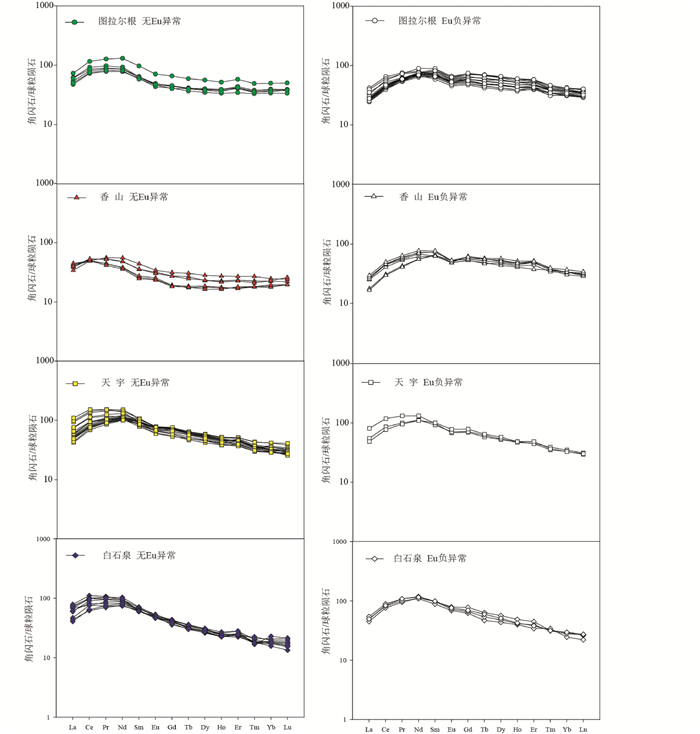
|
图 4 图拉尔根、香山、天宇、白石泉矿床角闪石的球粒陨石标准化稀土元素配分图解(标准化值据Sun and McDonough, 1989) Fig. 4 Chondrites-normalized REE patterns of amphiboles from Tulaergen, Xiangshan, Tianyu and Baishiquan deposits (normalization values after Sun and McDonough, 1989) |
角闪石的原始地幔标准化微量元素蛛网图见图 5。由数据和图解可见,这四个矿区的微量元素特征比较一致,除香山地区无Eu异常的角闪石中相对富集高场强元素Zr(103×10-6~350×10-6,平均为180×10-6)和Hf(4×10-6~8×10-6,平均为5.4×10-6)外,其他样品都具有Zr、Hf的弱负异常。所有样品的Nb、Ta均无异常,说明这些元素地球化学行为发生了解耦。相较于图拉尔根和香山角闪石的大离子亲石元素Rb(0.72×10-6~3.59×10-6,平均为1.73×10-6)、Ba(31.57×10-6~125.3×10-6,平均为91.74×10-6)和Th(0.04×10-6~0.55×10-6,平均为0.17×10-6)的含量,天宇和白石泉这些元素的变化范围大的多,且其平均含量要高(Rb:0.31×10-6~5.98×10-6,平均为2.65×10-6;Ba:15.88×10-6~288.5×10-6,平均为166.04×10-6;Th:0.02×10-6~2.26×10-6,平均为0.35×10-6)。
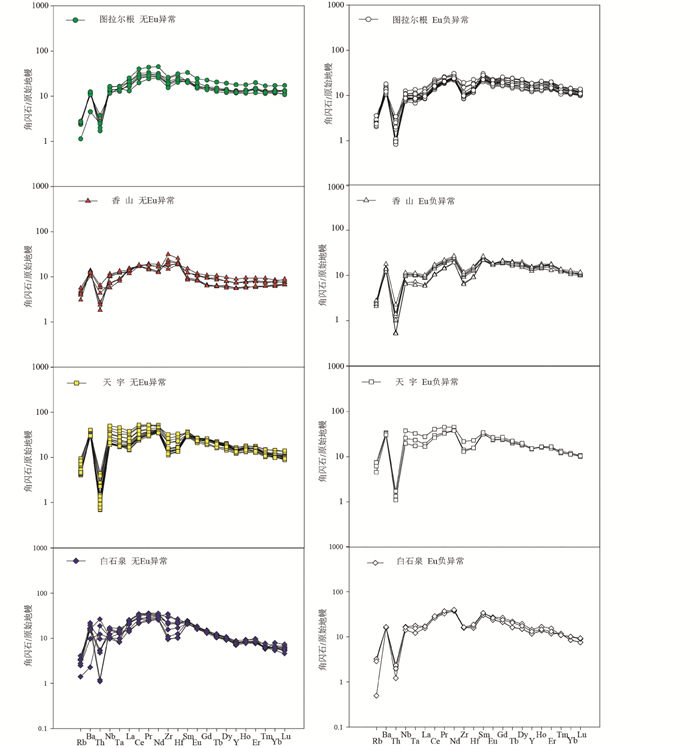
|
图 5 图拉尔根、香山、天宇、白石泉矿床角闪石的原始地幔标准化微量元素图解(标准化值据Sun and McDonough, 1989) Fig. 5 Primitive mantle-normalized trace elements patterns of amphiboles from Tulaergen, Xiangshan, Tianyu and Baishiquan deposits (normalization values after Sun and McDonough, 1989) |
四个矿床岩石样品中大多数角闪石自形程度较好,具有良好的长柱状或菱形晶形(图 2a-c),呈嵌晶结构或包橄结构(图 2b, c),未见反应边,具有均一的干涉色,指示这些角闪石都是从岩浆中结晶形成。天宇和白石泉矿床岩石样品的存在少量自形程度较差的角闪石(包括天宇1400-3-6的冻蓝闪石),干涉色不均一,可能为热液交代成因。部分角闪石核部是韭闪石,边部是浅闪石(图 2d),同一样品不同产状的角闪石具有不同的地球化学特征。自形程度良好、呈嵌晶结构或包橄结构的角闪石SiO2含量范围是41.5%~45%,Al2O3含量范围是11%~13%,Nb含量在5×10-6~30×10-6之间;而自形程度较差、干涉色不均一的角闪石具有更高的SiO2含量(45%~47%)、更低的Al2O3含量(6.5%~10%)且其微量元素Nb含量小于1×10-6,Ta含量也较前者低一个数量级,这些角闪石结晶温度较低,低于实验岩石学测定的低压下含水玄武质体系中角闪石的液相线温度(~900℃; Spulber and Rutherford, 1983)。低温下平衡的颗粒可能最初是岩浆成因的,但它们的主量元素在亚固相、热液改造和变形等过程中被重置(Gillis and Meyer, 2001),干涉色不均一也很可能是角闪石受到后期热液改造所致。Gillis et al. (2003)提出角闪石中Nb含量可以用来判断角闪石类型,因为Nb在热液改造过程中活动性低,更倾向于留在硅酸盐矿物中,因而高Nb(>1×10-6)可能指示了角闪石是岩浆成因的。根据Molina et al. (2009)的研究,我们将角闪石的TiO2含量与四次配位的Al原子数投图(图 6)。经过综合的比对,天宇和白石泉矿区显微镜下所见的自形程度较差、干涉色不均一的角闪石具有较低的形成温度、其Nb含量均小于1×10-6且落在TiO2-Al图解的次生趋势线上,故认为天宇和白石泉两个矿区确实存在少量后期热液交代成因的次生角闪石(如图 2d中浅闪石)。图 6中显示了大部分天宇岩体角闪石的TiO2含量要高于图拉尔根和香山的,这可能与母岩浆的Ti含量有关。这与前人的研究显示的天宇母岩浆中的Ti含量要略高于图拉尔根和香山岩体母岩浆中的Ti含量一致(肖庆华等, 2010; 唐冬梅等, 2009; 孙赫等, 2008)。

|
图 6 图拉尔根、香山、天宇、白石泉矿床角闪石TiO2 (%)-Al (T)相关性图(趋势线据Molina et al., 2009修改) Fig. 6 Plot of TiO2 (%) vs. Al (T) of amphiboles from Tulaergen, Xiangshan, Tianyu and Baishiquan deposits (the trend of primitive and secondary amphiboles modified after Molina et al., 2009) |
Molina et al. (2009)提出,角闪石中TiO2的含量是建立岩浆碱度的有用参数,根据TiO2和K2O的相关性图解(图 7),我们可以看出,图拉尔根、香山和白石泉这三个矿区的角闪石结晶是岩浆的碱度变化范围较大,从碱性到亚碱性都有,说明天宇的岩浆更偏碱性而另三个矿床的岩浆随着结晶分异作用从亚碱性到碱性变化。

|
图 7 图拉尔根、香山、天宇、白石泉矿床角闪石TiO2-K2O相关性图(底图据Molina et al., 2009) Fig. 7 Plot of TiO2 vs. K2O of amphiboles from Tulaergen, Xiangshan, Tianyu and Baishiquan deposits (base map after Molina et al., 2009) |
Putirka (2016)的研究表明,角闪石的结晶温度与其Si原子数和Mg#值具有负相关关系,与其Al原子数、Na原子数和Ti原子数具有正相关关系,据此,他提出角闪石的结晶温度与其组分的关系式:

|
(1) |
公式(1)中,SiAmp、TiAmp、NaAmp分别代表了基于23个氧原子所计算出的角闪石的阳离子个数,FetotalAmp代表了铁离子的总数,此公式的误差范围是±30℃。表 3总结了不同矿区角闪石结晶的温度范围和平均值。根据公式(1)计算得出图拉尔根和香山原生角闪石结晶温度分别在997~1065℃和982~1062℃之间。天宇原生角闪石结晶温度略高,在990~1081℃之间,平均为1054℃,白石泉原生角闪石的结晶温度在939~1065℃之间,平均为1026℃(图 8)。图拉尔根、香山、天宇和白石泉成矿岩体的角闪石结晶温度的方差分别为311、652、410和881。由此可以看出,觉罗塔格构造带内香山角闪石结晶温度(平均值为1013℃)和图拉尔根角闪石结晶温度(平均值为1027℃)虽然在误差范围内不存在明显差别,但香山角闪石结晶温度分布更为离散,大多样品的估算温度也相对更低。这可能是因为图拉尔根赋矿岩相为角闪橄榄岩,而香山的岩相为角闪辉石橄榄岩,图拉尔根赋矿岩相较为单一且结晶相对较早,其温度也略高。这与冯延清等(2017)使用橄榄石尖晶石Al温度计计算得出黄山岩体群(包括黄山、香山、黄山东等)内成矿岩体母岩浆的结晶温度介于1143~1257℃之间,略低于白鑫滩和图拉尔根岩体群(1283~1301℃)的结论一致。柴凤梅等(2006)根据玄武岩中MgO与橄榄石的结晶温度关系计算出白石泉岩体橄榄石开始的结晶温度为1295℃,根据斜方辉石中Ca离子数计算得出辉石的结晶温度范围在1058~1163℃之间,本文中计算的白石泉岩体原生角闪石的结晶温度在939~1065℃之间,说明此岩体橄榄石最先结晶,辉石次之,然后是角闪石,这与镜下观察的、岩相学特征相吻合(图 2a-c),也符合鲍文反应序列中镁铁质矿物的结晶顺序。天宇和白石泉的角闪石结晶温度变化范围都较大,这可能由于岩浆侵位过程中遭受了不同强度的混染作用,相对较晚结晶的角闪石,其主量成分反映了混染作用后岩浆系统的温度变化。
|
|
表 3 四个矿区角闪石成分限定的地化特征参数总结和对比 Table 3 The summary and comparison of geochemical parameters of Tulaergen, Xiangshan, Tianyu and Baishiquan deposits constrained by the composition of amphiboles |
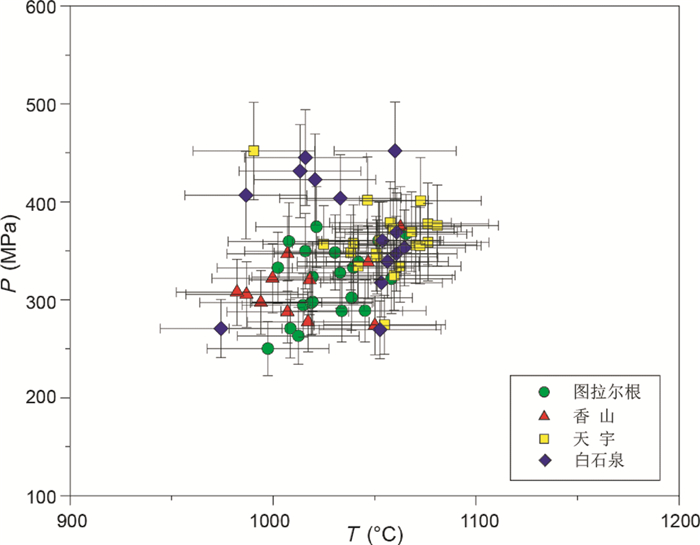
|
图 8 图拉尔根、香山、天宇和白石泉矿床原生角闪石的结晶温度和压力 Fig. 8 The crystallizing temperature and pressure of primary amphiboles from Tulaergen, Xiangshan, Tianyu and Baishiquan |
Ridolfi and Renzulli (2012)指出Ridolfi et al. (2010)给出的压力计算公式在P≤500MPa时是可以参考的,误差小于±44MPa:

|
(3) |
利用公式(3),计算得到觉罗塔格构造带内图拉尔根角闪石结晶压力在250~374MPa之间,平均为318MPa,香山角闪石结晶压力在274~374MPa之间,平均为313MPa(表 3),这与前人(冯延清等, 2017)使用单斜辉石压力计计算的此区岩体结晶压力(310~330MPa)一致。中天山地块天宇和白石泉角闪石结晶压力普遍高于觉罗塔格带内角闪石的结晶压力,分别在274~452MPa和269~452MPa之间,平均为361MPa和370MPa(表 3、图 8)。根据压力计算深度可以得出,图拉尔根和香山的侵位深度在11~12km之间,天宇和白石泉的侵位深度在12~15km之间,这可能是岩浆上升侵位时所处的构造背景的差异导致的。觉罗塔格构造带是晚古生代沟弧带,由康古尔裂谷带和雅满苏岛弧带组成(苏春乾等, 2008),中天山地块由前寒武基底岩石组成(黄博涛等, 2014),前者深大断裂和相对伸展的构造普遍要比后者发育,具有更多的岩浆向上迁移的空间,利于岩浆快速向浅表的位置侵位。
4.3 岩浆水含量和氧逸度估算根据Ridolfi et al. (2010)提出的公式,我们同样计算了这四个矿床角闪石结晶时岩浆的水含量(公式4)和氧逸度(公式5)。

|
(4) |
其中,[6]Al*=[6]Al+[4]Al/13.9-(Si+[6]Ti)/5-CFe2+/3-Mg/1.7+(BCa+A[])/1.2+ANa/2.7-1.56K-Fe#/1.6,Fe#=Fe3+/(Fetotal+Mg+Mn),此公式的误差为±0.41%。

|
(5) |
其中,Mg*=Mg+Si/47-[6]Al/9-1.3[6]Ti+Fe3+/3.7+Fe2+/5.2-BCa/20-ANa/2.8+A[]/9.5,此公式的误差为±0.22(log units)。压力,母岩浆的氧逸度和水含量计算均通过Ridolfi et al. (2010)给出的计算excel表格‘Amp-TB’实现。
图拉尔根角闪石结晶时,熔体的含水量变化范围是3.4%~5.1%,平均为4.4%,香山角闪石结晶时,熔体的含水量变化范围是4.1%~5.1%,平均为4.6%,天宇和白石泉角闪石结晶时的熔体含水量普遍更高,分别在2.8%~6.7%和2.9%~5.8%之间,熔体平均水含量分别为3.7%和4.5%(表 3)。由图 9也可以看出,这四个地区,角闪石开始结晶时,熔体的水含量普遍比较高并且变化范围大,说明角闪石的结晶离不开共存的富水熔体。富水熔体的产生可能是由于原始岩浆相对富水,也可能是原始岩浆经过结晶分异作用结晶出橄榄石、辉石,使得角闪石晶出时熔体的水含量升高。原始岩浆的水含量与其所处的构造背景息息相关。中天山地块在新元古代和早志留世分别受到了南天山洋向北的俯冲作用和准噶尔洋向南的俯冲作用,觉罗塔格构造带在早志留世受到了准噶尔洋向南的俯冲作用(Su et al., 2011)。水对于俯冲带岩浆的形成具有重要的意义(Cervantes and Wallace, 2003; Grove et al., 2012),Sobolev and Chaussidon (1996)的实验表明,俯冲带产生的初始岩浆含水量在1.0%~2.9%之间,Plank et al. (2013)认为基性弧岩浆的初始含水量在4%左右。然而这四个矿床成矿岩体均形成于晚二叠世,处于后碰撞伸展背景下(孙赫等, 2008; Chai et al., 2008; 唐冬梅等, 2009),其母岩浆初始含水量理应低于俯冲带背景下母岩浆的含水量。而玄武质熔体通过分离结晶作用可以使熔体中的水含量由0.6%上升至3.5%~6.7%(Xu et al., 2014)。研究区角闪石开始结晶时,熔体的含水量已高达4%左右,这可能是地幔源区早期经受过俯冲作用,其含水量本身较高且角闪石的结晶相对较晚共同作用的结果。

|
图 9 图拉尔根、香山、天宇和白石泉矿床角闪石结晶时熔体的水含量变化范围图解 Fig. 9 Plot of H2O in melts when amphiboles crystallized in Tulaergen, Xiangshan, Tianyu and Baishiquan |
Brenan and Caciagli (2000)与Barnes et al. (2013)的研究表明,硫化物熔体和橄榄石饱和的硅酸盐熔体之间的交换系数KD [(XNiS/XFeS)sulfide/(XNiO/XFeO)olivine]与硫化物熔体中Ni含量、岩浆的氧逸度之间存在相关性。根据此关系,前人计算出世界上部分Ni-Cu硫化物矿床的镁铁-超镁铁质杂岩体岩浆氧逸度范围,发现其并不如我们想象的那么还原(Barnes et al., 2013; Duan et al., 2016; Mao et al., 2018; 冯延清等, 2017),虽然Voisey’s Bay岩体的氧逸度普遍 < QFM-1,但Stillwater、Mirabela、金川岩浆的氧逸度大多分布为0<QFM<1。东天山的成矿镁铁-超镁铁质岩氧逸度范围是-2 < SQFM < 1,总体上讲变化较大,但其中觉罗塔格构造带内图拉尔根和香山的氧逸度变化范围较窄,分别为-2 < QFM < -1和-1 < QFM < 0,中天山地块天宇的氧逸度变化范围略大,为-2 < QFM < 0,与本文根据Ridolfi et al. (2010)提出的公式由角闪石计算出的氧逸度变化范围一致(图 10)。角闪石结晶时,图拉尔根和香山岩体岩浆的氧逸度分别是0.2 < ΔNNO < 1.6和0 < ΔNNO < 1.7,天宇和白石泉的母岩浆氧逸度变化范围较大,分别为-0.6 < ΔNNO < 1.7和-0.4 < ΔNNO < 1.8,多数样品揭示了低的氧逸度特征(表 3)。岩浆的氧逸度与角闪石的Mg#值(Mg#=Mg/(Mg+Fe2+))具有正相关关系(图 11),这与前人的实验研究结果是吻合的(Anderson and Smith, 1995; Scaillet and Evans, 1999; El-Rahman et al., 2012; Shane and Smith, 2013)。东天山铜镍矿区镁铁-超镁铁质岩的岩浆迁移过程中可能受到了地壳中较为还原的端元混染,故其在演化过程中变得越来越还原(Mao et al., 2018)。在岩浆演化过程中,白石泉和天宇矿区的角闪石比图拉尔根和香山矿区的角闪石揭示的氧逸度变化范围更大且氧逸度低的颗粒更多,这可能是因为白石泉和天宇位于具有古老结晶基底的中天山地块,母岩浆上升侵位过程中受到混染的比例更大且更加不均一所致。此外,角闪石的Fe3+/Fetotal与岩浆的氧逸度具有良好的正相关关系(图 12),或能作为岩浆氧逸度可靠的指示剂(King et al., 2000)。

|
图 10 图拉尔根、香山、天宇和白石泉矿床角闪石结晶时岩浆的温度和氧逸度相关性图(底图据Ridolfi et al., 2010) Fig. 10 Plot of the temperature and the oxygen fugacity of the magma when amphiboles crystallized in Tulaergen, Xiangshan, Tianyu and Baishiquan (base map after Ridolfi et al., 2010) |
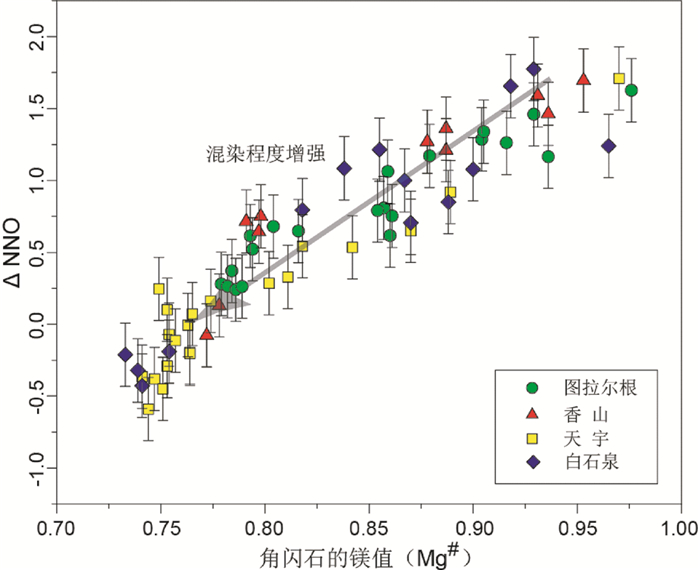
|
图 11 图拉尔根、香山、天宇和白石泉矿床岩浆角闪石计算的岩浆氧逸度(ΔNNO)和角闪石镁值(Mg#)相关性图 Fig. 11 Plot of the oxygen fugacity of the magma and the Mg# values of amphiboles from Tulaergen, Xiangshan, Tianyu and Baishiquan |
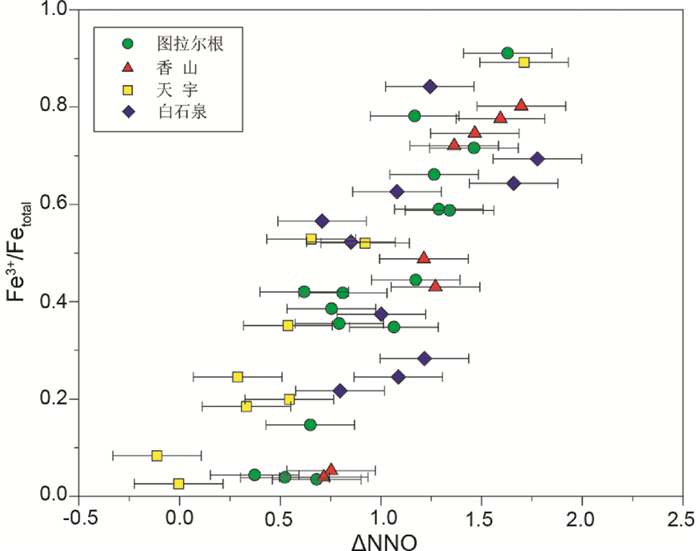
|
图 12 图拉尔根、香山、天宇和白石泉矿床角闪石计算的岩浆ΔNNO和角闪石Fe3+/Fetotal相关性图 Fig. 12 Plot of the oxygen fugacity of the magma and the Fe3+/Fetotal values of amphibole from Tulaergen, Xiangshan, Tianyu and Baishiquan |
图拉尔根、香山、天宇和白石泉矿区角闪石的稀土配分模式都有两种,其一不存在Eu异常,其二存在弱Eu负异常。其中,不存在Eu异常的角闪石的轻稀土含量略高(图 4),Murphy et al. (2012)认为这类角闪石可能是堆晶相橄榄石和辉石与囿于其中的间隙熔体发生反应形成的,其结晶早于斜长石并继承了间隙熔体富LREE的特征,即这些角闪石开始结晶于深部,是被富水岩浆带上来的(Pitcher, 1997);而El-Rahman et al. (2012)则认为这类角闪石是较晚结晶的,从而造成LREE富集和高场强元素的亏损,但是其不能解释无负Eu异常。本研究中剔除了热液成因的角闪石,所有岩浆成因的角闪石均呈嵌晶结构或包橄结构,无反应边,并不是早期结晶相和粒间熔体反应所成,且赋矿岩体的斜长石含量都较低。因而,本区具有弱负Eu异常可能是少量斜长石较早的分离结晶所致,受控于斜长石晶出;不具有负Eu异常的角闪石可能结晶较晚,随着岩浆的演化和后期地壳物质混染增强,岩浆中轻稀土的总含量较高,且其受斜长石晶出的影响变小,角闪石中弱的负Eu异常亦被抹去。
根据是否存在弱负Eu异常,将四个矿床角闪石的微量元素也分为两组(图 5)。其中,白石泉和天宇矿区的角闪石微量元素含量总体要大于图拉尔根和香山的,这可能是因为图拉尔根和香山的角闪石结晶分异作用发生的更早或其母岩浆微量元素含量本身就较低。天宇和白石泉角闪石中大离子亲石元素Rb、Ba和Th的含量变化范围较图拉尔根和香山角闪石大的多,且其平均含量要高,即中天山地块中岩体角闪石的不相容元素更为富集,变化范围更大,这可能是母岩浆侵位过程中所受的地壳混染作用更强的缘故,也可能是母岩浆遭受了俯冲交代的结果。这与Tang et al. (2012)根据多种地质现象、微量元素特征和Re-Os同位素数据同样得出的这四个矿区都曾遭到地壳混染和俯冲交代作用,且天宇和白石泉受到的混染作用更强的结论相一致。
Ce比Pb更不相容,Nb和U的不相容性相似,但Nb的不相容性略大于U(Sun and McDonough, 1989)。将Ce/Pb-Nb和Nb/U-Ce/Pb进行投图(图 13)可见,天宇和白石泉矿区的Ce/Pb比值总体上要低于图拉尔根和香山矿区的,且图拉尔根和白石泉矿区的角闪石Ce/Pb值可以明显地区分成两部分。角闪石中减小的Ce/Pb值指示了壳源物质的混染(Demény et al., 2012),由此可见,中天山地块的天宇和白石泉地区遭受的混染强于觉罗塔格带内的。这与大离子亲石元素含量特征和计算得出的氧逸度所反映的混染情况是一致的。
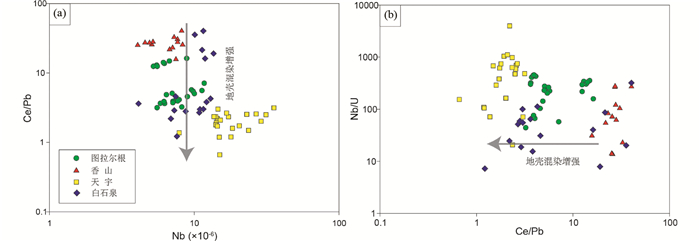
|
图 13 图拉尔根、香山、天宇和白石泉矿床角闪石中Nb-Ce/Pb (a)和Ce/Pb-Nb/U (b)的相关性图 Fig. 13 Plots of Ce/Pb vs. Nb (a) and Ce/Pb vs. Nb/U (b) of amphiboles from Tulaergen, Xiangshan, Tianyu and Baishiquan |
东天山图拉尔根、香山、天宇和白石泉矿区的角闪石均为钙角闪石,主要由韭闪石、镁绿钙闪石、浅闪石、钛闪石、镁角闪石和镁钙闪石组成。觉罗塔格带内图拉尔根和香山的角闪石结晶温度和压力均低于天宇和白石泉的(平均分别为1027℃/318MPa、1013℃/313MPa、1054℃/361MPa和1026℃/370MPa),说明前二者岩浆的侵位深度较浅,可能与觉罗塔格构造带断裂构造更为发育,有利于岩浆迁移到浅处结晶有关。东天山铜镍矿区角闪石结晶时岩浆的含水量较高(4%左右),可能是地幔源区曾受到俯冲交代作用故保留了部分俯冲弧岩浆的特征,且角闪石结晶较晚,二者共同作用导致角闪石结晶时共存熔体水含量较高。东天山铜镍矿的形成或与富水的交代地幔源区息息相关。这四个矿床越演化的岩浆,还原程度越高,这可能是因为岩浆演化过程中受还原地壳混染作用变强,此过程或对成矿有着积极的作用。白石泉和天宇矿区角闪石的更低的氧逸度(最低可达ΔNNO=-0.4)以及较低的微量元素Ce/Pb比值指示了岩浆迁移过程中受到了更强烈的古老还原地壳的混染作用。由此可见,角闪石成分能够从多个方面提供铜镍矿床的岩浆结晶温度压力、共存熔体水含量、氧逸度及地壳还原物质混染等方面的重要信息,进而揭示成矿作用。
致谢 研究工作中,与中国地质大学(北京)薛胜超博士进行了多次讨论,获益良多,十分感谢。此外,感谢新疆有色地勘局三金柱总工程师、新疆地矿局第六大队邓刚总工程师和多位技术人员在野外工作中给予的支持和帮助。稿件承蒙刊物主编及两位审稿专家悉心审理,提出建设性的宝贵意见,在此致以衷心感谢。
Adam J, Oberti R, Cámara F and Green TH. 2007. An electron microprobe, LAM-ICP-MS and single-crystal X-ray structure refinement study of the effects of pressure, melt-H2O concentration and fO2 on experimentally produced basaltic amphiboles. European Journal of Mineralogy, 19(5): 641-655 DOI:10.1127/0935-1221/2007/0019-1750 |
Allen JC and Boettcher AL. 1983. The stability of amphibole in andesite and basalt at high pressures. American Mineralogist, 68(3-4): 307-314 |
Anderson JL and Smith DR. 1995. The effects of temperature and fO2 on the Al-in-hornblende barometer. American Mineralogist, 80(5-6): 549-559 DOI:10.2138/am-1995-5-614 |
Bachmann O and Dungan MA. 2002. Temperature-induced Al-zoning in hornblendes of the Fish Canyon magma, Colorado. American Mineralogist, 87(8-9): 1062-1076 DOI:10.2138/am-2002-8-903 |
Barnes SJ, Godel B, Gürer D, Brenan JM, Robertson J and Paterson D. 2013. Sulfide-olivine Fe-Ni exchange and the origin of anomalously Ni rich magmatic sulfides. Economic Geology, 108(8): 1972-1982 |
Blundy JD and Holland TJB. 1990. Calcic amphibole equilibria and a new amphibole-plagioclase geothermometer. Contributions to Mineralogy and Petrology, 104(2): 208-224 DOI:10.1007/BF00306444 |
Bottazzi P, Tiepolo M, Vannucci R, Zanetti A, Brumm R, Foley SF and Oberti R. 1999. Distinct site preferences for heavy and light REE in amphibole and the prediction of Amph/LDREE. Contributions to Mineralogy and Petrology, 137(1-2): 36-45 DOI:10.1007/s004100050580 |
Brenan JM and Caciagli NC. 2000. Fe-Ni exchange between olivine and sulphide liquid: Implications for oxygen barometry in sulphide-saturated magmas. Geochimica et Cosmochimica Acta, 64(2): 307-320 DOI:10.1016/S0016-7037(99)00278-1 |
Browne BL and Gardner JE. 2006. The influence of magma ascent path on the texture, mineralogy, and formation of hornblende reaction rims. Earth and Planetary Science Letters, 246(3-4): 161-176 DOI:10.1016/j.epsl.2006.05.006 |
Bucholz CE, Jagoutz O, Schmidt MW and Sambuu O. 2014. Fractional crystallization of high-K arc magmas: Biotite-versus amphibole-dominated fractionation series in the Dariv Igneous Complex, Western Mongolia. Contributions to Mineralogy and Petrology, 168(5): 1072 DOI:10.1007/s00410-014-1072-9 |
Cervantes P and Wallace PJ. 2003. Role of H2O in subduction-zone magmatism: New insights from melt inclusions in high-Mg basalts from Central Mexico. Geology, 31(3): 235-238 DOI:10.1130/0091-7613(2003)031<0235:ROHOIS>2.0.CO;2 |
Chai FM, Zhang ZC, Mao JW, Dong LH, Ye HS, Wu H and Mo XH. 2006. Platinum group elements geochemistry of Baishiquan mafic-ultramafic intrusives in Central Tianshan Block, Xinjiang. Acta Geoscientica Sinica, 27(2): 123-128 (in Chinese with English abstract) |
Chai FM, Zhang ZC, Mao JW, Dong LH, Zhang ZH and Wu H. 2008. Geology, petrology and geochemistry of the Baishiquan Ni-Cu-bearing mafic-ultramafic intrusions in Xinjiang, NW China: Implications for tectonics and genesis of ores. Journal of Asian Earth Sciences, 32(2-4): 218-235 DOI:10.1016/j.jseaes.2007.10.014 |
Dalpé C and Baker DR. 2000. Experimental investigation of large-ion-lithophile-element-, high-field-strength-element- and rare-earth-element-partitioning between calcic amphibole and basaltic melt: The effects of pressure and oxygen fugacity. Contributions to Mineralogy and Petrology, 140(2): 233-250 DOI:10.1007/s004100000181 |
Demény A, Harangi S, Vennemann TW, Casillas R, Horváth P, Milton AJ, Mason PRD and Ulianov A. 2012. Amphiboles as indicators of mantle source contamination: Combined evaluation of stable H and O isotope compositions and trace element ratios. Lithos, 152: 141-156 DOI:10.1016/j.lithos.2012.07.001 |
Deng YF, Song XY, Chen LM, Cheng SL, Zhang XL and Li J. 2011. Features of the mantle source of the Huangshanxi Ni-Cu sulfide-bearing mafic-ultramafic intrusion, eastern Tianshan. Acta Petrologica Sinica, 27(12): 3640-3652 (in Chinese with English abstract) |
Dessimoz M, Müntener O and Ulmer P. 2012. A case for hornblende dominated fractionation of arc magmas: The Chelan Complex (Washington Cascades). Contributions to Mineralogy and Petrology, 163(4): 567-589 DOI:10.1007/s00410-011-0685-5 |
Duan J, Li CS, Qian ZZ, Jiao JG, Ripley EM and Feng YQ. 2016. Multiple S isotopes, zircon Hf isotopes, whole-rock Sr-Nd isotopes, and spatial variations of PGE tenors in the Jinchuan Ni-Cu-PGE deposit, NW China. Mineralium Deposita, 51(4): 557-574 DOI:10.1007/s00126-015-0626-8 |
El-Rahman YA, Helmy HM, Shibata T, Yoshikawa M, Arai S and Tamura A. 2012. Mineral chemistry of the Neoproterozoic Alaskan-type Akarem Intrusion with special emphasis on amphibole: Implications for the pluton origin and evolution of subduction-related magma. Lithos, 155: 410-425 DOI:10.1016/j.lithos.2012.09.015 |
Erdmann S, Martel C, Pichavant M and Kushnir A. 2014. Amphibole as an archivist of magmatic crystallization conditions: Problems, potential, and implications for inferring magma storage prior to the paroxysmal 2010 eruption of Mount Merapi, Indonesia. Contributions to Mineralogy and Petrology, 167(6): 1016 DOI:10.1007/s00410-014-1016-4 |
Feng YQ, Qian ZZ, Xu G, Duan J, Chen BL, Sun T, Jiang C and Ren M. 2017. Rock-forming mineral features of Permian mineralized mafic-ultramafic intrusions in East Tianshan Mountains and their implications for intrusion generation. Acta Petrologica et Mineralogica, 36(4): 519-534 (in Chinese with English abstract) |
Gillis KM and Meyer PS. 2001. Metasomatism of oceanic gabbros by late stage melts and hydrothermal fluids: Evidence from the rare earth element composition of amphiboles. Geochemistry, Geophysics, Geosystems, 2(3): 2000G |
Gillis KM, Coogan LA and Chaussidon M. 2003. Volatile element (B, Cl, F) behaviour in the roof of an axial magma chamber from the East Pacific Rise. Earth and Planetary Science Letters, 213(3-4): 447-462 DOI:10.1016/S0012-821X(03)00346-7 |
Grove TL, Till CB and Krawczynski MJ. 2012. The role of H2O in subduction zone magmatism. Annual Review of Earth and Planetary Sciences, 40: 413-439 DOI:10.1146/annurev-earth-042711-105310 |
Hammarstrom JM and Zen E. 1986. Aluminum in hornblende: An empirical igneous geobarometer. American Mineralogist, 71(11-12): 1297-1313 |
Hilyard M, Nielsen RL, Beard JS, Patinõ-Douce A and Blencoe J. 2000. Experimental determination of the partitioning behavior of rare earth and high field strength elements between pargasitic amphibole and natural silicate melts. Geochimica et Cosmochimica Acta, 64(6): 1103-1120 DOI:10.1016/S0016-7037(99)00379-8 |
Hsu YJ, Zajacz Z, Ulmer P and Heinrich CA. 2017. Copper partitioning between silicate melts and amphibole: Experimental insight into magma evolution leading to porphyry copper ore formation. Chemical Geology, 448: 151-163 DOI:10.1016/j.chemgeo.2016.11.019 |
Huang BT, He ZY, Qing ZK and Zhang ZM. 2014. Zircon U-Pb and Hf isotopic study of Neoproterozoic granitic gneisses from the Alatage area, Xinjiang: Constraints on the Precambrian crustal evolution in the Central Tianshan Block. Chinese Science Bulletin, 59(1): 100-112 DOI:10.1007/s11434-013-0010-y |
Jiang CY and An SY. 1984. On chemical characteristics of calcic amphiboles from igneous rocks and their petrogenesis significance. Journal of Mineralogy and Petrology, (3): 1-8 (in Chinese with English abstract) |
Jiang CY, Zhang PB, Lu DR and Bai BY. 2004. Petrogenesis and magma source of the ultramafic rocks at Wajilitag region, western Tarim Plate in Xinjiang. Acta Petrologica Sinica, 20(6): 1433-1444 (in Chinese with English abstract) |
King PL, Hervig RL, Holloway JR, Delaney JS and Dyar MD. 2000. Partitioning of Fe3+/Fetotal between amphibole and basanitic melt as a function of oxygen fugacity. Earth and Planetary Science Letters, 178(1-2): 97-112 DOI:10.1016/S0012-821X(00)00071-6 |
Klein M, Stosch HG and Seck HA. 1997. Partitioning of high field-strength and rare-earth elements between amphibole and quartz-dioritic to tonalitic melts: An experimental study. Chemical Geology, 138(3-4): 257-271 DOI:10.1016/S0009-2541(97)00019-3 |
Krawczynski MJ, Grove TL and Behrens H. 2012. Amphibole stability in primitive arc magmas: Effects of temperature, H2O content, and oxygen fugacity. Contributions to Mineralogy and Petrology, 164(2): 317-339 DOI:10.1007/s00410-012-0740-x |
Leake BE, Woolley AR, Arps CES, Birch WD, Gilbert MC, Grice JD, Hawthorne FC, Kato A, Kisch HJ, Krivovichev VG, Linthout K, Laird J, Mandarino JA, Maresch WV, Nickel EH, Rock NMS, Schumacher JC, Smith DC, Stephenson NCN, Ungaretti L, Whittaker EJW and Guo YZ. 1997. Nomenclature of amphiboles: Report of the Subcommittee on Amphiboles of the International Mineralogical Association, Commission on New Minerals and Mineral Names. The Canadian Mineralogist, 35(1): 219-246 |
Li CS, Naldrett AJ and Ripley EM. 2007. Controls on the Fo and Ni contents of olivine in sulfide-bearing mafic/ultramafic intrusions: Principles, modeling, and examples from Voisey's Bay. Earth Science Frontiers, 14(5): 177-183 DOI:10.1016/S1872-5791(07)60043-8 |
Liu YR, Lü XB, Mei W and Hui WD. 2012. Compositions of olivine from the mafic-ultramafic complexs in eastern Tianshan, Xinjiang and implications to petrogenesus: Examples from Huangshandong and Tulargen complexes. Geochimica, 41(1): 78-88 (in Chinese with English abstract) |
Liu YS, Hu ZC, Gao S, Günther D, Xu J, Gao CG and Chen HH. 2008. In situ analysis of major and trace elements of anhydrous minerals by LA-ICP-MS without applying an internal standard. Chemical Geology, 257(1-2): 34-43 DOI:10.1016/j.chemgeo.2008.08.004 |
Ma RS, Wang CY and Ye SF. 1993. Tectonic Framework and Crustal Evolution of Eastern Tianshan Mountains. Nanjing: Publishing House of Nanjing University (in Chinese)
|
Mao JW, Pirajno F, Zhang ZH, Chai FM, Wu H, Chen SP, Cheng LS, Yang JM and Zhang CQ. 2008. A review of the Cu-Ni sulphide deposits in the Chinese Tianshan and Altay orogens (Xinjiang Autonomous Region, NW China): Principal characteristics and ore-forming processes. Journal of Asian Earth Sciences, 32(2-4): 184-203 DOI:10.1016/j.jseaes.2007.10.006 |
Mao QG, Xiao WJ, Han CM, Sun M, Yuan C, Yan Z, Li JL, Yong Y and Zhang JE. 2006. Zircon U-Pb age and the geochemistry of the Baishiquan mafic-ultramafic complex in the Eastern Tianshan, Xinjiang Province: Constraints on the closure of the Paleo-Asian Ocean. Acta Petrologica Sinica, 22(1): 153-162 (in Chinese with English abstract) |
Mao YJ, Qin KZ, Li CS, Xue SC and Ripley EM. 2014. Petrogenesis and ore genesis of the Permian Huangshanxi sulfide ore-bearing mafic-ultramafic intrusion in the Central Asian Orogenic Belt, western China. Lithos, 200-201: 111-125 DOI:10.1016/j.lithos.2014.04.008 |
Mao YJ, Qin KZ, Tang DM, Feng HY and Xue SC. 2016. Crustal contamination and sulfide immiscibility history of the Permian Huangshannan magmatic Ni-Cu sulfide deposit, East Tianshan, NW China. Journal of Asian Earth Sciences, 129: 22-37 DOI:10.1016/j.jseaes.2016.07.028 |
Mao YJ, Qin KZ, Barnes SJ, Tang DM, Xue SC and Le Vaillant M. 2017. Genesis of the Huangshannan high-Ni tenor magmatic sulfide deposit in the Eastern Tianshan, Northwest China: Constraints from PGE geochemistry and Os-S isotopes. Ore Geology Reviews, 90: 591-606 DOI:10.1016/j.oregeorev.2017.05.015 |
Mao YJ, Qin KZ, Barnes SJ, Ferraina C, Iacono-Marziano G, Verrall M, Tang DM and Xue SC. 2018. A revised oxygen barometry in sulfide-saturated magmas and application to the Permian magmatic Ni-Cu deposits in the southern Central Asian Orogenic Belt. Mineralium Deposita, 53(6): 731-755 DOI:10.1007/s00126-017-0771-3 |
Marks M, Halama R, Wenzel T and Markl G. 2004. Trace element variations in clinopyroxene and amphibole from alkaline to peralkaline syenites and granites: Implications for mineral-melt trace-element partitioning. Chemical Geology, 211(3-4): 185-215 DOI:10.1016/j.chemgeo.2004.06.032 |
Molina JF, Scarrow JH, Montero PG and Bea F. 2009. High-Ti amphibole as a petrogenetic indicator of magma chemistry: Evidence for mildly alkalic-hybrid melts during evolution of Variscan basic-ultrabasic magmatism of Central Iberia. Contributions to Mineralogy and Petrology, 158(1): 69-98 DOI:10.1007/s00410-008-0371-4 |
Murphy JB, Blais SA, Tubrett M, McNeil D and Middleton M. 2012. Microchemistry of amphiboles near the roof of a mafic magma chamber: Insights into high level melt evolution. Lithos, 148: 162-175 DOI:10.1016/j.lithos.2012.06.012 |
Nandedkar RH, Ulmer P and Müntener O. 2014. Fractional crystallization of primitive, hydrous arc magmas: An experimental study at 0.7GPa. Contributions to Mineralogy and Petrology, 167(6): 1015 DOI:10.1007/s00410-014-1015-5 |
Otten MT. 1984. The origin of brown hornblende in the Artfjället gabbro and dolerites. Contributions to Mineralogy and Petrology, 86(2): 189-199 DOI:10.1007/BF00381846 |
Pitcher WS. 1997. The Nature and Origin of Granite. London: Chapman and Hall
|
Plank T, Kelley KA, Zimmer MM, Hauri EH and Wallace PJ. 2013. Why do mafic arc magmas contain ~4wt% water on average?. Earth and Planetary Science Letters, 364: 168-179 DOI:10.1016/j.epsl.2012.11.044 |
Polat A. 2014. A review of the geodynamic significance of hornblende-bearing ultramafic rocks in the Mesoarchean Fiskenaesset complex, SW Greenland. In: Dilek Y and Furnes H (eds.). Evolution of Archean Crust and Early Life. Dordrecht: Springer, 127-147
|
Putirka K. 2016. Amphibole thermometers and barometers for igneous systems and some implications for eruption mechanisms of felsic magmas at arc volcanoes. American Mineralogist, 101(4): 841-858 DOI:10.2138/am-2016-5506 |
Qin KZ, Fang TH, Wang SL, Zhu BQ, Feng YM, Yu HF and Xiu QY. 2002. Plate tectonics division, evolution and metallogenic settings in eastern Tianshan Mountains, NW-China. Xinjiang Geology, 20(4): 302-308 (in Chinese with English abstract) |
Qin KZ, Xu XW, Liang GH, Fang TH, Ding KS, San JZ, Zhang LC, Hui WD, Peng XM, Wu H, Cheng SL, Xu YX, Sun H, Miao Y, Mo XH, Cai XP, Kang F, Zhang BL and Xiao QH. 2006. Advance in research on metallogenetic regularity, target selection and location prognosis for large-scale Cu, Ni and Au deposits at eastern Tianshan. Mineral Deposits, 25 (in Chinese) |
Qin KZ, Ding KS, Xu YX, Sun H, Xu XW, Tang DM and Mao Q. 2007. Ore potential of protoliths and modes of Co-Ni occurrence in Tulargen and Baishiquan Cu-Ni-Co deposits, East Tianshan, Xinjiang. Mineral Deposits, 26(1): 1-14 (in Chinese with English abstract) |
Qin KZ, Su BX, Sakyi PA, Tang DM, Li XH, Sun H, Xiao QH and Liu PP. 2011. SIMS zircon U-Pb geochronology and Sr-Nd isotopes of Ni-Cu-bearing mafic-ultramafic intrusions in Eastern Tianshan and Beishan in correlation with flood basalts in Tarim Basin (NW China): Constraints on a ca. 280Ma mantle plume. American Journal of Science, 311(3): 237-260 |
Qin QX. 2003. Geological character of the ilmenite deposit in western part of Xiangshan and its genesis. Mineral Resources and Geology, 17(4): 533-535 (in Chinese with English abstract) |
Ridolfi F, Puerini M, Renzulli A, Menna M and Toulkeridis T. 2008. The magmatic feeding system of El Reventador volcano (Sub-Andean zone, Ecuador) constrained by texture, mineralogy and thermobarometry of the 2002 erupted products. Journal of Volcanology and Geothermal Research, 176(1): 94-106 DOI:10.1016/j.jvolgeores.2008.03.003 |
Ridolfi F, Renzulli A and Puerini M. 2010. Stability and chemical equilibrium of amphibole in calc-alkaline magmas: An overview, new thermobarometric formulations and application to subduction-related volcanoes. Contributions to Mineralogy and Petrology, 160(1): 45-66 DOI:10.1007/s00410-009-0465-7 |
Ridolfi F and Renzulli A. 2012. Calcic amphiboles in calc-alkaline and alkaline magmas: Thermobarometric and chemometric empirical equations valid up to 1, 130℃ and 2.2GPa. Contributions to Mineralogy and Petrology, 163(5): 877-895 DOI:10.1007/s00410-011-0704-6 |
Rutherford MJ and Devine JD. 2003. Magmatic conditions and magma ascent as indicated by hornblende phase equilibria and reactions in the 1995~2002 Soufrière Hills Magma. Journal of Petrology, 44(8): 1433-1454 DOI:10.1093/petrology/44.8.1433 |
Rutherford MJ and Iii JDD. 2008. Magmatic conditions and processes in the storage zone of the 2004~2006 Mount St. Helens Dacite. In: Sherrod DR, Scott WE and Stauffer PH (eds.). A Volcano Rekindled: The Renewed Eruption of Mount St. Helens, 2004~2006. Reston: U.S. Geological Survey, 703-725
|
San JZ, Qin KZ, Tang ZL, Tang DM, Su BX, Sun H, Xiao QH and Liu PP. 2010. Precise zircon U-Pb age dating of two mafic-ultramafic complexes at Tulargen large Cu-Ni district and its geological implications. Acta Petrologica Sinica, 26(10): 3027-3035 (in Chinese with English abstract) |
Scaillet B and Evans BW. 1999. The 15 June 1991 Eruption of Mount Pinatubo. I. Phase equilibria and pre-eruption P-T-fO2-fH2O conditions of the dacite magma. Journal of Petrology, 40(3): 381-411 |
Shane P and Smith VC. 2013. Using amphibole crystals to reconstruct magma storage temperatures and pressures for the post-caldera collapse volcanism at Okataina volcano. Lithos, 156-159: 159-170 DOI:10.1016/j.lithos.2012.11.008 |
Shi Y, Wang YW, Wang JB, Zhao LT, Xie HJ, Long LL, Zou T, Li DD and Zhou GC. 2018. Physicochemical control of the Early Permian Xiangshan Fe-Ti oxide deposit in Eastern Tianshan (Xinjiang), NW China. Journal of Earth Science, 29(3): 520-536 DOI:10.1007/s12583-017-0969-4 |
Sobolev AV and Chaussidon M. 1996. H2O concentrations in primary melts from supra-subduction zones and mid-ocean ridges: Implications for H2O storage and recycling in the mantle. Earth and Planetary Science Letters, 137(1-4): 45-55 DOI:10.1016/0012-821X(95)00203-O |
Spulber SD and Rutherford MJ. 1983. The origin of rhyolite and plagiogranite in oceanic crust: An experimental study. Journal of Petrology, 24(1): 1-25 |
Stone WE, Deloule E and Stone MS. 2003. Hydromagmatic amphibole in komatiitic, tholeiitic and ferropicritic units, Abitibi greenstone belt, Ontario and Québec: Evidence for Archaean wet basic and ultrabasic melts. Mineralogy and Petrology, 77(1-2): 39-65 DOI:10.1007/s00710-002-0194-3 |
Su BX, Qin KZ, Sakyi PA, Li XH, Yang YH, Sun H, Tang DM, Liu PP, Xiao QH and Malaviarachchi SPK. 2011. U-Pb ages and Hf-O isotopes of zircons from Late Paleozoic mafic-ultramafic units in the southern Central Asian Orogenic Belt: Tectonic implications and evidence for an Early-Permian mantle plume. Gondwana Research, 20(2-3): 516-531 DOI:10.1016/j.gr.2010.11.015 |
Su BX, Qin KZ, Sun H, Tang DM, Xiao QH, Liu PP and Sakyi PA. 2012. Olivine compositional mapping of mafic-ultramafic complexes in eastern Xinjiang (NW China): Implications for Cu-Ni mineralization and tectonic dynamics. Journal of Earth Science, 23(1): 41-53 DOI:10.1007/s12583-012-0232-y |
Su CQ, Jiang CY, Xia MZ, Zhang L, Ji HG, Guo FF and Liu XJ. 2008. Zircon SHRIMP U-Pb dating from granite of the metamorphic core complex system in Jueluotage tectonic belt and its geological significance. Acta Petrologica Sinica, 24(12): 2789-2799 (in Chinese with English abstract) |
Sun H, Qin KZ, Li JX, Xu XW, San JZ, Ding KS, Hui WD and Xu YX. 2006. Petrographic and geochemical characteristics of the Tulargen Cu-Ni-Co sulfide deposit, East Tianshan, Xinjiang, and its tectonic setting. Geology in China, 33(3): 605-617 (in Chinese with English abstract) |
Sun H, Qin KZ, Xu XW, Li JX, Ding KS, Xu YX and San JZ. 2007. Petrological characteristics and copper-nickel ore-forming processes of Early Permian mafic-ultramafic intrusion belts in East Tianshan. Mineral Deposits, 26(1): 98-108 (in Chinese with English abstract) |
Sun H, Qin KZ, Li JX, Tang DM, Fan X and Xiao QH. 2008. Constraint of mantle partial melting on PGE mineralization of mafic-ultramafic intrusions in Eastern Tianshan: Case study on Tulargen and Xiangshan Cu-Ni deposits. Acta Petrologica Sinica, 24(5): 1079-1086 (in Chinese with English abstract) |
Sun SS and McDonough WF. 1989. Chemical and isotopic systematics of oceanic basalts: Implications for mantle composition and processes. In: Saunders AD and Norry MJ (eds.). Magmatism in the Ocean Basins. Geological Society, London, Special Publications, 42(1): 313-345
|
Sun T, Qian ZZ, Deng YF, Li C, Song XY and Tang Q. 2013. PGE and isotope (Hf-Sr-Nd-Pb) constraints on the origin of the Huangshandong magmatic Ni-Cu sulfide deposit in the Central Asian Orogenic Belt, Northwestern China. Economic Geology, 108(8): 1849-1864 DOI:10.2113/econgeo.108.8.1849 |
Tang DM, Qin KZ, Sun H, Su BX, Xiao QH, Cheng SL and Li J. 2009. Lithological, chronological and geochemical characteristics of Tianyu Cu-Ni deposit: Constraints on source and genesis of mafic-ultramafic intrusions in eastern Xinjiang. Acta Petrologica Sinica, 25(4): 817-831 (in Chinese with English abstract) |
Tang DM, Qin KZ, Li CS, Qi L, Su BX and Qu WJ. 2011. Zircon dating, Hf-Sr-Nd-Os isotopes and PGE geochemistry of the Tianyu sulfide-bearing mafic-ultramafic intrusion in the Central Asian Orogenic Belt, NW China. Lithos, 126(1-2): 84-98 DOI:10.1016/j.lithos.2011.06.007 |
Tang DM, Qin KZ, Sun H, Su BX and Xiao QH. 2012. The role of crustal contamination in the formation of Ni-Cu sulfide deposits in Eastern Tianshan, Xinjiang, Northwest China: Evidence from trace element geochemistry, Re-Os, Sr-Nd, zircon Hf-O, and sulfur isotopes. Journal of Asian Earth Sciences, 49: 145-160 DOI:10.1016/j.jseaes.2011.11.014 |
Tang DM, Qin KZ, Su BX, Sakyi PA, Liu YS, Mao Q, Santosh M and Ma YG. 2013. Magma source and tectonics of the Xiangshanzhong mafic-ultramafic intrusion in the Central Asian Orogenic Belt, NW China, traced from geochemical and isotopic signatures. Lithos, 170-171: 144-163 DOI:10.1016/j.lithos.2013.02.013 |
Thornber CR, Pallister JS, Lowers H, Rowe MC, Mandeville CW and Meeker GP. 2008. Chemistry, mineralogy, and petrology of amphibole in Mount St. Helens 2004~2006 dacite. In: Sherrod DR, Scott WE and Stauffer PH (eds.). A Volcano Rekindled: The Renewed Eruption of Mount St. Helens, 2004~2006. Washington: U.S. Geological Survey, 727-754
|
Tiepolo M, Oberti R, Zanetti A, Vannucci R and Foley SF. 2007. Trace-element partitioning between amphibole and silicate melt. Reviews in Mineralogy and Geochemistry, 67(1): 417-452 DOI:10.2138/rmg.2007.67.11 |
Turner SJ, Izbekov P and Langmuir C. 2013. The magma plumbing system of Bezymianny Volcano: Insights from a 54year time series of trace element whole-rock geochemistry and amphibole compositions. Journal of Volcanology and Geothermal Research, 263: 108-121 DOI:10.1016/j.jvolgeores.2012.12.014 |
Ulmer P. 2007. Differentiation of mantle-derived calc-alkaline magmas at mid to lower crustal levels: Experimental and petrologic constraints. Periodico di Mineralogia, 76(2-3): 309-325 |
Xiao QH, Qin KZ, Tang DM, Su BX, Sun H, San JZ, Cao MJ and Hui WD. 2010. Xiangshanxi composite Cu-Ni-Ti-Fe deposit belongs to comagmatic evolution product: Evidences from ore microscopy, zircon U-Pb chronology and petrological geochemistry, Hami, Xinjiang, NW China. Acta Petrologica Sinica, 26(2): 503-522 (in Chinese with English abstract) |
Xiao WJ, Zhang LC, Qin KZ, Sun S and Li JL. 2004. Paleozoic accretionary and collisional tectonics of the eastern Tianshan (China): Implications for the continental growth of central Asia. American Journal of Science, 304(4): 370-395 |
Xu Z, Zheng YF, Zhao ZF and Gong B. 2014. The hydrous properties of subcontinental lithospheric mantle: Constraints from water content and hydrogen isotope composition of phenocrysts from Cenozoic continental basalt in North China. Geochimica et Cosmochimica Acta, 143: 285-302 DOI:10.1016/j.gca.2013.12.025 |
Xue SC, Qin KZ, Tang DM, Mao YJ and Yao ZS. 2015. Compositional characteristics of pyroxenes from Permian mafic-ultramafic complexes in Eastern Xinjiang, and their implications for petrogenesis and Ni-Cu mineralization. Acta Petrologica Sinica, 31(8): 2175-2192 (in Chinese with English abstract) |
Yavuz F. 2007. WinAmphcal: A Windows program for the IMA-04 amphibole classification. Geochemistry, Geophysics, Geosystems, 8(1): Q01004 |
Zhao Y, Xue CJ, Liu SA, Symons DTA, Zhao XB, Yang YQ and Ke JJ. 2017. Copper isotope fractionation during sulfide-magma differentiation in the Tulaergen magmatic Ni-Cu deposit, NW China. Lithos, 286-287: 206-215 DOI:10.1016/j.lithos.2017.06.007 |
Zhou MF, Lesher CM, Yang ZX, Li JW and Sun M. 2004. Geochemistry and petrogenesis of 270Ma Ni-Cu-(PGE) sulfide-bearing mafic intrusions in the Huangshan district, Eastern Xinjiang, Northwest China: Implications for the tectonic evolution of the Central Asian orogenic belt. Chemical Geology, 209(3-4): 233-257 DOI:10.1016/j.chemgeo.2004.05.005 |
Zhu GQ, Yang SF and Chen HL. 1995. Studies of rock and ore controlling structures of Xiangshan Cu-Ni bearing mafic-ultramafic complex, eastern Xinjiang. Contributions to Geology and Mineral Resources Research, 10(3): 1-13 (in Chinese with English abstract) |
柴凤梅, 张招崇, 毛景文, 董连慧, 叶会寿, 吴华, 莫新华. 2006. 新疆哈密白石泉含铜镍镁铁-超镁铁质岩体铂族元素特征. 地球学报, 27(2): 29-34. |
邓宇峰, 宋谢炎, 陈列锰, 程松林, 张新利, 李军. 2011. 东天山黄山西含铜镍矿镁铁-超镁铁岩体岩浆地幔源区特征研究. 岩石学报, 27(12): 3640-3652. |
冯延清, 钱壮志, 徐刚, 段俊, 陈炳龙, 孙涛, 姜超, 任萌. 2017. 东天山二叠纪镁铁-超镁铁质成矿岩体造岩矿物特征及其成因意义. 岩石矿物学杂志, 36(4): 519-534. DOI:10.3969/j.issn.1000-6524.2017.04.006 |
黄博涛, 贺振宇, 宗克清, 张泽明. 2014. 新疆阿拉塔格地区新元古代花岗片麻岩的锆石U-Pb定年与Hf同位素:对中天山地块前寒武纪地壳演化的制约. 科学通报, 59(3): 287-296. |
姜常义, 安三元. 1984. 论火成岩中钙质角闪石的化学组成特征及其岩石学意义. 矿物岩石, (3): 1-8. |
姜常义, 张蓬勃, 卢登荣, 白开寅. 2004. 新疆塔里木板块西部瓦吉里塔格地区二叠纪超镁铁岩的岩石成因与岩浆源区. 岩石学报, 20(6): 1433-1444. |
刘艳荣, 吕新彪, 梅微, 惠卫东. 2012. 新疆东天山镁铁-超镁铁岩体中橄榄石成分特征及其成因意义:以黄山东和图拉尔根为例. 地球化学, 41(1): 78-88. |
马瑞士, 王赐银, 叶尚夫. 1993. 东天山构造格架及地壳演化. 南京: 南京大学出版社.
|
毛启贵, 肖文交, 韩春明, 孙敏, 袁超, 闫臻, 李继亮, 雍拥, 张继恩. 2006. 新疆东天山白石泉铜镍矿床基性-超基性岩体锆石U-Pb同位素年龄、地球化学特征及其对古亚洲洋闭合时限的制约. 岩石学报, 22(1): 153-162. |
秦克章, 方同辉, 王书来, 朱宝清, 冯益民, 于海峰, 修群业. 2002. 东天山板块构造分区、演化与成矿地质背景研究. 新疆地质, 20(4): 302-308. DOI:10.3969/j.issn.1000-8845.2002.04.002 |
秦克章, 徐兴旺, 梁光河, 方同辉, 丁奎首, 三金柱, 张连昌, 惠卫东, 彭晓明, 吴华, 程松林, 许英霞, 孙赫, 缪宇, 莫新华, 蔡新平, 康峰, 张宝林, 肖庆华. 2006. 东天山东段大型铜、镍、金矿床成矿规律研究、靶区优选与隐伏矿定位预测的重要进展. 矿床地质, 25(增1): 301-304. |
秦克章, 丁奎首, 许英霞, 孙赫, 徐兴旺, 唐冬梅, 毛骞. 2007. 东天山图拉尔根、白石泉铜镍钴矿床钴、镍赋存状态及原岩含矿性研究. 矿床地质, 26(1): 1-14. DOI:10.3969/j.issn.0258-7106.2007.01.001 |
秦全新. 2003. 香山西段钛铁矿床地质特征及成因探讨. 矿产与地质, 17(4): 533-535. DOI:10.3969/j.issn.1001-5663.2003.04.009 |
三金柱, 秦克章, 汤中立, 唐冬梅, 苏本勋, 孙赫, 肖庆华, 刘平平. 2010. 东天山图拉尔根大型铜镍矿区两个镁铁-超镁铁岩体的锆石U-Pb定年及其地质意义. 岩石学报, 26(10): 3027-3035. |
苏春乾, 姜常义, 夏明哲, 张雷, 姬厚贵, 郭芳放, 刘秀金. 2008. 新疆觉罗塔格构造带新元古代变质核杂岩锆石U-Pb年龄与地质意义. 岩石学报, 24(12): 2789-2799. |
孙赫, 秦克章, 李金祥, 徐兴旺, 三金柱, 丁奎首, 惠卫东, 许英霞. 2006. 东天山图拉尔根铜镍钴硫化物矿床岩相、岩石地球化学特征及其形成的构造背景. 中国地质, 33(3): 605-617. |
孙赫, 秦克章, 徐兴旺, 李金祥, 丁奎首, 许英霞, 三金柱. 2007. 东天山镁铁质-超镁铁质岩带岩石特征及铜镍成矿作用. 矿床地质, 26(1): 98-108. DOI:10.3969/j.issn.0258-7106.2007.01.009 |
孙赫, 秦克章, 李金祥, 唐冬梅, 范新, 肖庆华. 2008. 地幔部分熔融程度对东天山镁铁质-超镁铁质岩铂族元素矿化的约束——以图拉尔根和香山铜镍矿为例. 岩石学报, 24(5): 1079-1086. |
唐冬梅, 秦克章, 孙赫, 苏本勋, 肖庆华, 程松林, 李军. 2009. 天宇铜镍矿床的岩相学、锆石U-Pb年代学、地球化学特征:对东疆镁铁-超镁铁质岩体源区和成因的制约. 岩石学报, 25(4): 817-831. |
肖庆华, 秦克章, 唐冬梅, 苏本勋, 孙赫, 三金柱, 曹明坚, 惠卫东. 2010. 新疆哈密香山西铜镍-钛铁矿床系同源岩浆分异演化产物——矿相学、锆石U-Pb年代学及岩石地球化学证据. 岩石学报, 26(2): 503-522. |
薛胜超, 秦克章, 唐冬梅, 毛亚晶, 姚卓森. 2015. 东疆二叠纪镁铁-超镁铁岩体中辉石的成分特征及其对成岩和Ni-Cu成矿的指示. 岩石学报, 31(8): 2175-2192. |
竺国强, 杨树锋, 陈汉林. 1995. 东疆香山铜镍含矿镁铁超镁铁杂岩体控岩控矿构造探讨. 地质找矿论丛, 10(3): 1-13. |
 2019, Vol. 35
2019, Vol. 35




